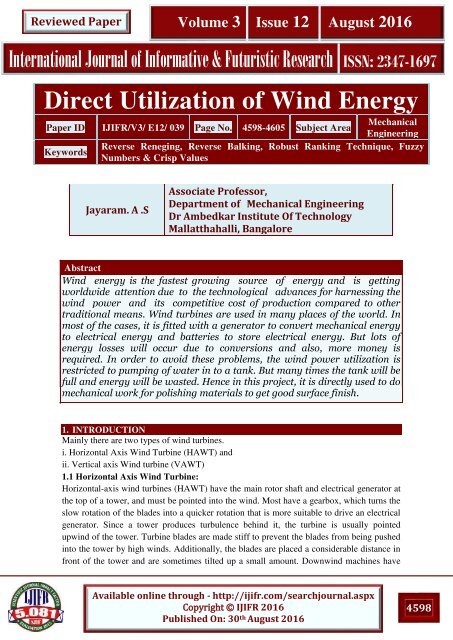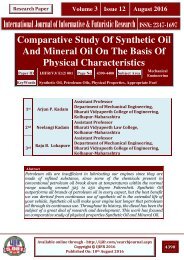IJIFR VOLUME 3 ISSUE 12 AUGUST 2016
RESEARCH PAPER
RESEARCH PAPER
Create successful ePaper yourself
Turn your PDF publications into a flip-book with our unique Google optimized e-Paper software.
Reviewed Paper<br />
Volume 3 Issue <strong>12</strong> August <strong>2016</strong><br />
International Journal of Informative & Futuristic Research ISSN: 2347-1697<br />
Direct Utilization of Wind Energy<br />
Mechanical<br />
Paper ID <strong>IJIFR</strong>/V3/ E<strong>12</strong>/ 039 Page No. 4598-4605 Subject Area<br />
Engineering<br />
Reverse Reneging, Reverse Balking, Robust Ranking Technique, Fuzzy<br />
Keywords<br />
Numbers & Crisp Values<br />
Jayaram. A .S<br />
Associate Professor,<br />
Department of Mechanical Engineering<br />
Dr Ambedkar Institute Of Technology<br />
Mallatthahalli, Bangalore<br />
Abstract<br />
Wind energy is the fastest growing source of energy and is getting<br />
worldwide attention due to the technological advances for harnessing the<br />
wind power and its competitive cost of production compared to other<br />
traditional means. Wind turbines are used in many places of the world. In<br />
most of the cases, it is fitted with a generator to convert mechanical energy<br />
to electrical energy and batteries to store electrical energy. But lots of<br />
energy losses will occur due to conversions and also, more money is<br />
required. In order to avoid these problems, the wind power utilization is<br />
restricted to pumping of water in to a tank. But many times the tank will be<br />
full and energy will be wasted. Hence in this project, it is directly used to do<br />
mechanical work for polishing materials to get good surface finish.<br />
1. INTRODUCTION<br />
Mainly there are two types of wind turbines.<br />
i. Horizontal Axis Wind Turbine (HAWT) and<br />
ii. Vertical axis Wind turbine (VAWT)<br />
1.1 Horizontal Axis Wind Turbine:<br />
Horizontal-axis wind turbines (HAWT) have the main rotor shaft and electrical generator at<br />
the top of a tower, and must be pointed into the wind. Most have a gearbox, which turns the<br />
slow rotation of the blades into a quicker rotation that is more suitable to drive an electrical<br />
generator. Since a tower produces turbulence behind it, the turbine is usually pointed<br />
upwind of the tower. Turbine blades are made stiff to prevent the blades from being pushed<br />
into the tower by high winds. Additionally, the blades are placed a considerable distance in<br />
front of the tower and are sometimes tilted up a small amount. Downwind machines have<br />
Available online through - http://ijifr.com/searchjournal.aspx<br />
Copyright © <strong>IJIFR</strong> <strong>2016</strong><br />
Published On: 30 th August <strong>2016</strong><br />
4598



